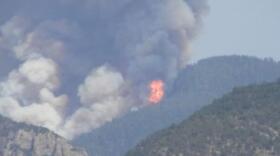Two years ago last June, the Shultz Fire filled the skies north of Flagstaff with smoke. By the time it was controlled, 15,000 acres of Coconino National Forest land had burned including the ponderosa pines that would have absorbed much of the subsequent rainfall. A month later monsoon rains drenched the area
T-V Newscaster - The raging flood has come and gone. Now, hundreds in flagstaff are left to pull their lives out of the mud.
"The Shultz Fire in 2010 burned on the other side of the peaks, on the other side of Dry Lake Hills and we saw the consequences," Marcus Selig said. He is the Arizona Forest Program Manager for the Grand Canyon Trust.
Selig says the devastation caused by the Shultz Fire could happen again on the south side of hills.
"If the wind had blown the other way or if the fire had started down at the Shultz Creek Trailhead, we’d have been looking at a very similar situation here on the south and west side of the peaks and Dry Lake Hills and that flooding would have occurred downtown," he said.
The ballot measure, known as Question 405 would pay to thin the forest in the Dry Lakes Hills area. Looking north from downtown Flagstaff, Dry Lake Hills are the rolling hills just this side of Mt. Humphreys. The pricetag on the ballot measure is $10 million. But Selig says the potential devastation from a wildfire and subsequent flooding would far exceed that amount…
"We would definitely have a steady flow of water moving thru town and that water would be carrying debris," he said. "It would be carrying logs and boulders. It would overflow the banks of the Rio de Flag and get into people’s home and businesses and flood the buildings on campus."
So, how likely is it that this could happen?
We asked Abe Springer a Professor of Geology at Northern Arizona University. Springer says the downtown area, including the surrounding neighborhoods and the NAU campus could have a 10-times greater peak run-off from a storm event following a catastrophic wildfire. And that’s actually a conservative estimate.
"When we look at Shultz flooding," Springer said, "In some cases, some of those channels had a thousand times greater run-off after the flood."
Question 405 also provides money for forest thinning in an area south of flagstaff. Again, federal land near Lake Mary. Similar scenario: if fire burns away the trees, flooding could follow and that could affect the quality of water in Lake Mary. That watershed provides Flagstaff with a significant amount of its drinking water.
Marcus Selig from the Grand Canyon Trust said the result would be "sedimentation into Lake Mary which would displace a lot of storage capacity and even change the chemical composition of Lake Mary making that an unusable reservoir. And we get about 50% of our drinking water from Lake Mary so we’d have to drill new wells to make up for that which gets quite costly."
The City of Flagstaff puts out an information pamphlet in each election cycle. The pamphlet provides a forum for various arguments for and against a particular ballot measure. But for Question 405, no arguments against were submitted. Although some Flagstaff residents may question why they’re being asked to pay for forest thinning on federal land?
"Its unclear whether the forest service would ever have the money to finish the project," Selig said . "What the bond election would do is expedite the work or get work done that would not otherwise be done. The Forest Service does not have the money to do such intense work on such a small acreage."
Voters also may be asking, why not allow private enterprise to take on the project?
"The difficulty here is that because of the steep slopes, it is not cost-effective to thin," Selig said. "So it is an expensive area to treat. The acreage is not that great but the fact of the steep slopes would require hand-thinning which is not cost-effective and the value of the product taken off will not offset the cost of doing the treatments."
So, a $10 million bond election. How much will it cost the average Flagstaff resident? Kimberly Ott is spokesperson for the City Manager’s Office. Ott says the tax rate will remain the same even if 405 passes. Meaning, no increase in property taxes…
"As we’re paying old debt down," Ott said, "we issue new bonds so we would, as we’re paying debt down we would issue bonds for the forest health-water supply project. So that way the taxpayer will never see an increase as it relates to their tax rate."
It also means the taxpayer would never see a tax de
crease either, even as old debt is retired. In the case of Question 405, if voters shoot it down, the City Council would have a decision to make. They could keep the tax rate the same…
"Or, lower the tax rate so the taxpayer would actually see a decrease in that rate," Ott said.
Meaning property taxes would drop. Voters will decide the fate of Question 405 on Tuesday.
To see more information about the areas to be thinned, click here



